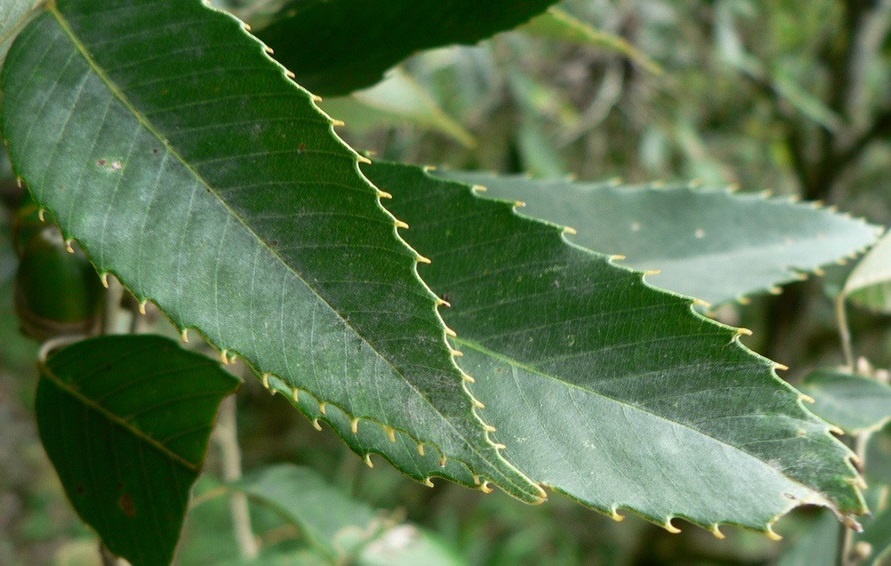Quercus liaoi
(Quercus liaoi)

Description
Quercus liaoi is a species of oak tree that belongs to the family Fagaceae, also known as Liaoning oak. It is native to northeastern China, specifically to the Liaoning province, where it was discovered in 1998. Since then, it has gained interest from plant enthusiasts and botanists due to its distinct features and potential use in the forestry industry. Description Quercus liaoi is a deciduous tree that can grow up to 15 meters in height, with a trunk diameter of up to 50 centimeters. The bark is gray and rough, with deep furrows that become more prominent as the tree ages. The leaves are alternate and simple, with a length of 5-15 cm and a width of 2-8 cm. The leaves are dark green on the upper surface and pale green on the lower surface, with a slightly serrated margin. The leaves turn yellow or brown in the fall before falling off. The flowers of Quercus liaoi are monoecious, meaning that both male and female flowers are present on the same tree. The male flowers are borne on pendulous catkins, while the female flowers are borne on short spikes. The fruit is an acorn, which is round and about 2-3 cm in diameter. The acorns are enclosed in a cupule that is covered with small, bristly hairs. Distribution and Habitat Quercus liaoi is native to northeastern China, specifically to the Liaoning province. It is found in mixed forests along with other tree species such as Fraxinus mandshurica, Tilia amurensis, and Acer mono. The species is not currently listed as endangered, although its habitat is threatened by deforestation and urbanization. Quercus liaoi prefers moist, well-drained soils and can tolerate a range of soil types including sand, loam, and clay. It is tolerant of drought and cold temperatures, making it suitable for cultivation in a variety of climates. Ecology Quercus liaoi is a valuable tree species in its native habitat, providing habitat and food for a variety of animals. The acorns are an important food source for squirrels, mice, and other small mammals, while the leaves are consumed by caterpillars and other insects. The tree is also used as a host plant for the caterpillar of the Lunar Moth (Actias selene). In addition to its ecological value, Quercus liaoi is also of economic importance. The wood is highly valued for its strength and durability, making it ideal for use in furniture, flooring, and construction. The tree is also used in traditional Chinese medicine, with the bark and leaves being used to treat a variety of ailments including fever, diarrhea, and dysentery. Cultivation Quercus liaoi is a relatively fast-growing tree that is easy to cultivate. It prefers moist, well-drained soils and can tolerate a range of soil types including sand, loam, and clay. The tree is tolerant of drought and cold temperatures, making it suitable for cultivation in a variety of climates. Propagation of Quercus liaoi is typically done by seed, with acorns being collected in the fall and sown immediately. The seeds require a period of cold stratification before they will germinate, which can be achieved by storing them in a refrigerator for several weeks. Once germinated, the seedlings can be transplanted to their permanent location after one year. Conservation Status Quercus liaoi is a relatively fast-growing tree that is easy to cultivate. It is not a widely cultivated species, but it has potential for commercial forestry and reforestation projects due to its ecological and economic value. The tree prefers moist, well-drained soils and can tolerate a range of soil types including sand, loam, and clay. It is also tolerant of drought and cold temperatures, making it suitable for cultivation in a variety of climates. Propagation of Quercus liaoi is typically done by seed, with acorns being collected in the fall and sown immediately. The seeds require a period of cold stratification before they will germinate, which can be achieved by storing them in a refrigerator for several weeks. Once germinated, the seedlings can be transplanted to their permanent location after one year. Conclusion Quercus liaoi is a valuable tree species that is native to northeastern China. It provides important ecological and economic benefits, making it a valuable asset in its native habitat. The tree is relatively easy to cultivate, making it a potential candidate for reforestation projects and commercial forestry. While the species is not currently endangered, conservation efforts are needed to protect its habitat from threats such as deforestation and urbanization.
Taxonomic tree:







